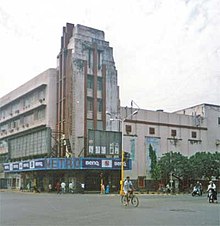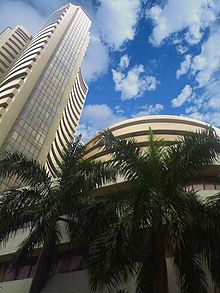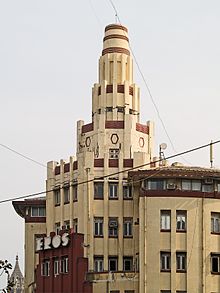Architecture of Mumbai
Where the neoclassical has an orderly monochromatic presence, the Gothic style is expressive, disjointed with surfaces of lives colors, beautified with carved and narrative elements, consisting of flying buttresses, lancet windows and stained glass.[4] Chhatrapati Shivaji Maharaj Terminus is a historic terminal train station and UNESCO World Heritage Site in Mumbai, Maharashtra, India.GG Scott's plans for Berlin's parliament building had been published four years before, and also has marked similarities to the station's design.This famous architectural landmark in a Gothic-revival style was built as the headquarters of the Great Indian Peninsular Railway.The skyline, turrets, pointed arches, and eccentric ground plan are close to classical Indian palace architecture.[5] It was designed by Sir George Gilbert Scott, an English architect, and was modeled on Big Ben, the clock tower of the United Kingdom's houses of Parliament in London.Watson's Hotel, currently known as the Esplanade Mansion, is located in the Kala Ghoda area of Mumbai and is India's oldest surviving cast iron building.[11] It was named after its original owner John Watson and designed by civil engineer Rowland Mason Ordish, who was also associated with the St Pancras Station in London.The main façade of the hotel is distinguished by wide, open balconies on each floor that connected the guest rooms, which were built around the atrium in a courtyard arrangement.The Gateway of India and Chhatrapati Shivaji Maharaj Vastu Sangrahalaya are good examples of this architectural type in the city.The Gateway of India was built to commemorate the visit of King George V and Queen Mary to Mumbai, prior to the Delhi Durbar, in December 1911.The main features of the Indo Saracenic Style were the construction of domes, arches, spires, stained glasses and minarets.Deco details touch every architectural aspect – lamps, flooring, wood paneling, lifts, railings and grills, muntins, chhajjas or weather shades, plinth copings and mouldings, cornices, verandahs and balconies, bronze and stainless steel fittings, brackets, etched glass, ornamental sculptures that extended to names carved out in giant letters, facades that are very airy and built in stepped -back style, etc.Mumbai's Art Deco stands out not only because it uses the easy blend of Deco-Saracenic but also because architects have used a variety of materials to express design freely.The Metro Inox Cinemas, located on Mahatma Gandhi Road, at Dhobitalao Junction is also a good example of the Art Deco style of architecture that appeared in the 1930s in the city.As the wealthiest city in India,[20] Mumbai attracts an enormous amount of international investment and has seen a large number of modern high-rise office buildings and flats spring up in recent decades.


MumbaiGothicVictorianArt DecoChhatrapati Shivaji Maharaj TerminusMunicipal Corporation Buildinggothic revivalFrederick William StevensneoclassicalVictorian Gothic styleJan MorrisThomas CowperFort campus of the University of MumbaiRajabai TowerSaint Xavier's CollegeWilson CollegeUNESCO World Heritage SiteMaharashtraVictorian ItalianateGothic Revival architectureBori Bunder railway station50 years of Queen Victoria's ruleShivajiMaratha EmpireChhatrapatiMaharajCentral RailwaysuburbanBori BunderAxel HaigSt Pancras railway stationLondonGG ScottGreat Indian Peninsular RailwayVictorian GothicSouth MumbaiUniversity of MumbaiGeorge Gilbert ScottBig BenVenetianstained glassCrawford Market FountainArthur CrawfordMunicipal CommissionerCowasji JehangirfriezesLockwood KiplingRudyard KiplingWatson's HotelKala Ghodacast ironRowland Mason OrdishSt Pancras StationCrystal PalaceatriumRenzo PianoWorld Monuments FundChhatrapati Shivaji Maharaj Vastu SangrahalayaGateway of IndiaIndo-Saracenic styleGeorge WittetIndo-SaracenicApollo Bunderbasaltreinforced concreteGujaratIslamic architectureKing George VQueen MaryDelhi DurbarSir George Sydenham ClarkeTaj Mahal PalaceengineerEiffel TowerArt Deco in Mumbaiespecially in New YorkChrysler BuildingEros CinemaMetro Inox CinemasThomas W. LambMarbleMahatma Gandhi RoadBombay Stock Exchangecontemporary architecturePalais RoyaleThe ImperialOne Avighna ParkMumbai Metropolitan Region Development AuthorityGovernment of MaharashtraTalati and PanthakyMahatma Jyotiba Phule MandaiFlora FountainKnesset EliyahooMumbai High CourtDavid Sassoon LibraryMount Mary ChurchAfghan ChurchSt. John the Baptist ChurchAndheriJesuitsSt. Thomas CathedralAnglicanSt. Michael's ChurchFranciscanMadh FortThe HinduAmerican AirlinesThe Indian ExpressExpress GroupMumbai MirrorTimes GroupRediff.comHistoryTimelineShilahara dynastyBombay PresidencySeven Islands of BombayElephanta CavesBanganga TankOld BombayWorli FortGirangaonSamyukta Maharashtra SamitiGrowth of Mumbai1992–93 riots1993 bombings

